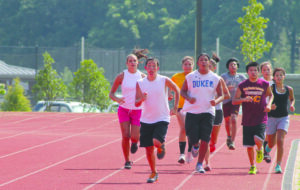By SCOTT MCKIE B.P.
ONE FEATHER STAFF
Physical inactivity is a global pandemic according to a researcher at the University of Texas School of Public Health. Harold W. Kohl, III, Ph.D., wrote in a paper about the dire consequences of living a lifestyle devoid of regular physical activity.

These members of the CHS Cross Country team are the exception rather than the norm when it comes to high school students. According to the CDC, less than 3 in 10 high school students get an hour of physical activity daily. (SCOTT MCKIE B.P./One Feather)
“Physical inactivity continues to be undervalued among people who can make a difference despite evidence of its health benefits and the evident cost burden posed by present levels of physical inactivity globally,” Kohl stated. “Although regular physical activity is critical for weight control, it is equally or more important for lowering risk of many different chronic diseases such as heart disease, some cancers, osteoporosis and diabetes.”
According to the CDC, less than 3 in 10 high school students get an hour of physical activity daily. Four years ago, the CDC developed Physical Activity Guidelines on which to gauge activity levels nationwide. CDC reported that men (52.1 percent) meet the guidelines at a larger percentage than women (42.6 percent).
In 2008, 24.5 percent of North Carolina adults reported no leisure-time activities (i.e. running, walking, golf, etc.) within the past month. Oklahoma was at the top with 31 percent reporting no activity. The national average was 25.4 percent reporting no activity.
“It is important to introduce physical activity to children at an early age,” Ahli-sha Stephens, exercise physiologist at Cherokee Life Center, and Lynn Taylor, wellness supervisor at Cherokee Life Center said in a statement. “It is helpful when parents set the example by participating in exercise such as swimming, walking/running or physically playing with their child. Children need to be physically active to develop bone and muscle and to strengthen their heart and lungs.”
“As they become teens and young adults, physical activity helps them to become stronger, enhance skills toward any athletic goal no matter what your fitness level is. Staying active for a lifetime will pay off as we age to live happier mentally and feel good physically. Exercise is a great stress, blood pressure, diabetes, and cholesterol reducer as well as an easy way to maintain balance and mobility. Get moving for all these reasons and much, much more!”
Kohl said health officials need to put more efforts into increasing physical activity. “The response to physical activity has been incomplete, unfocused, understaffed and underfunded compared with other risk factors for non-communicable diseases. This has put physical activity in reverse gear compared with population trends and advances in tobacco and alcohol control and diet.”


